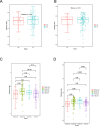Differences between the intestinal microbial communities of healthy dogs from plateau and those of plateau dogs infected with Echinococcus
- PMID: 38783310
- PMCID: PMC11112841
- DOI: 10.1186/s12985-024-02364-4
Differences between the intestinal microbial communities of healthy dogs from plateau and those of plateau dogs infected with Echinococcus
Abstract
Objective: Cystic echinococcosis (CE) represents a profoundly perilous zoonotic disease. The advent of viral macrogenomics has facilitated the exploration of hitherto uncharted viral territories. In the scope of this investigation, our objective is to scrutinize disparities in the intestinal microbiotic ecosystems of canines dwelling in elevated terrains and those afflicted by Echinococcus infection, employing the tool of viral macrogenomics.
Methods: In this study, we collected a comprehensive total of 1,970 fecal samples from plateau dogs infected with Echinococcus, as well as healthy control plateau dogs from the Yushu and Guoluo regions in the highland terrain of China. These samples were subjected to viral macrogenomic analysis to investigate the viral community inhabiting the canine gastrointestinal tract.
Results: Our meticulous analysis led to the identification of 136 viral genomic sequences, encompassing eight distinct viral families.
Conclusion: The outcomes of this study hold the potential to enhance our comprehension of the intricate interplay between hosts, parasites, and viral communities within the highland canine gut ecosystem. Through the examination of phage presence, it may aid in early detection or assessment of infection severity, providing valuable insights into Echinococcus infection and offering prospects for potential treatment strategies.
Keywords: Bacteriophage; Dog; Echinococcus; Intestinal microbial community.
© 2024. The Author(s).
Conflict of interest statement
The authors declare no competing interests.
Figures






Similar articles
-
The effects of dog management on Echinococcus spp. prevalence in villages on the eastern Tibetan Plateau, China.Parasit Vectors. 2020 Apr 21;13(1):207. doi: 10.1186/s13071-020-04082-6. Parasit Vectors. 2020. PMID: 32317015 Free PMC article.
-
First molecular identification of Echinococcus vogeli and Echinococcus granulosus (sensu stricto) G1 revealed in feces of domestic dogs (Canis familiaris) from Acre, Brazil.Parasit Vectors. 2017 Jan 14;10(1):28. doi: 10.1186/s13071-016-1952-0. Parasit Vectors. 2017. PMID: 28088247 Free PMC article.
-
Seasonal pattern of Echinococcus re-infection in owned dogs in Tibetan communities of Sichuan, China and its implications for control.Infect Dis Poverty. 2016 Jul 5;5(1):60. doi: 10.1186/s40249-016-0155-4. Infect Dis Poverty. 2016. PMID: 27377927 Free PMC article.
-
[Epidemiological characteristics of canine Echinococcus infection in Qinghai-Tibet Plateau of China].Zhongguo Xue Xi Chong Bing Fang Zhi Za Zhi. 2017 Apr 7;29(2):129-138. doi: 10.16250/j.32.1374.2017004. Zhongguo Xue Xi Chong Bing Fang Zhi Za Zhi. 2017. PMID: 29469312 Review. Chinese.
-
Canine echinococcosis: global epidemiology and genotypic diversity.Acta Trop. 2013 Dec;128(3):441-60. doi: 10.1016/j.actatropica.2013.08.002. Epub 2013 Aug 13. Acta Trop. 2013. PMID: 23954494 Review.
Cited by
-
Genetic characterization of the marmot gut virome in high-altitude Qinghai Province and identification of novel viruses with zoonotic potential.mSphere. 2025 Aug 26;10(8):e0029725. doi: 10.1128/msphere.00297-25. Epub 2025 Jul 31. mSphere. 2025. PMID: 40742122 Free PMC article.
References
-
- Díaz-Muñoz SL, Koskella B. Bacteria–Phage Interactions in Natural Environments. Adv Appl Microbiol. Elsevier; 2014 [cited 2023 May 25]. p. 135–83. Available from: https://linkinghub.elsevier.com/retrieve/pii/B9780128002599000044. - PubMed
Publication types
MeSH terms
Associated data
LinkOut - more resources
Full Text Sources
Medical

